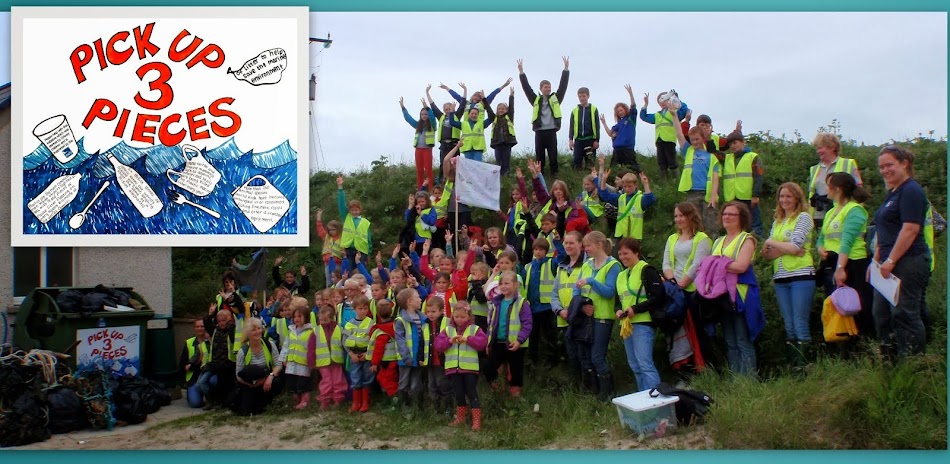Thanks to the Pick Up 3 Pieces campaign, we
now have a large bin for beach rubbish installed at The Ayre, a causeway near
Longhope. On both sides of this road are very special bays, delightful in many
ways with some interesting flora, fauna and geology. On the south side a
stretch of glorious sand attracts both local and visiting folk, be they
walkers, paddlers, seal watchers, fishermen or just beach lovers and in a
certain light the sea sparkles in exquisite turquoise hues. Occasionally we are
lucky enough to see orcas or basking sharks enter the bay. Across the road on the other side is the more
sheltered North Bay, rich in various shell fish and marine life, it is
important to many birds including ducks, divers and waders.

The
south bay known as Aith Hope opens out into the Pentland Firth and
unfortunately some of the rubbish that drifts about in the open seas can find
its way onto our lovely beach. Winter storms also bring in seaweed and much of
the rubbish ends up tangled amongst this tide line. Some of this bruck travels
a long way, for instance I have found lobster cage tags from Maine, USA and
milk cartons from Norway. Dedicated Bag the Bruckers annually clean up as much
rubbish as they can but the problem is constant.
Part of the PU3P campaign is to visit local
schools and discuss with the children sea life, tides, drifting patterns and the issues and problems associated with
marine litter, especially plastics, on our natural environment. The children of
North Walls School recently had a visit from Lesley Mackay, founder of PU3P.
Teachers and assistants then organised a trip to the beach for the children so
they could put into context what they have discussed at school.
It was great to meet them on the shore and
help them with the task in hand. Their enthusiasm and interest is a credit to
their teachers and Lesley. They scurried about picking up stuff from the
tiniest pieces of string to a welly boot, shotgun cartridges, rope, net, half a
pair of spectacles, bottles and other plastic detritus. Two young girls sat in
one place for a long time and sorted with utmost care through the seaweed
picking out every piece of plastic they could see. While other pupils charged
about more randomly picking up whatever caught their eye. I heard a teacher
encouraging them by giving them a challenge like 'find six blue things' or
'three round things'. I thought this a great idea as too much choice confused
the issue and rather than run about not knowing where to start they had a point
of focus. I watched two small lads make a gallant effort to raise a large lump
of old iron, that has laid half buried in the sand for decades.
In no time at all they had filled up their
bags and it was back to the bin, some children dragging long lengths of
rope. Before dumping it all in the bin
the booty was examined and the children rightfully praised for their
outstanding effort. Co-incidentally it happened that it was bin day and the
lorry turned up just at the right time. So they were able to watch the bin
being hoisted up and the rubbish safely dumped inside the truck. I think for
one or two children this was the icing on the cake!
So it is a step forward for our community to
have this prominently placed bin with eye catching sticker. We hope it will
stimulate future beach goers to follow the example our school children
magnificently set and to pick up some rubbish and dispose of it in the bin.
Well
done and thank you children, we are very proud of you all.





.jpg)


.jpg)


.jpg)






.jpg)
.JPG)
.jpg)
.jpg)
.jpg)